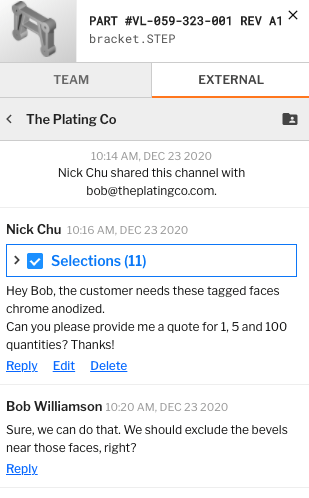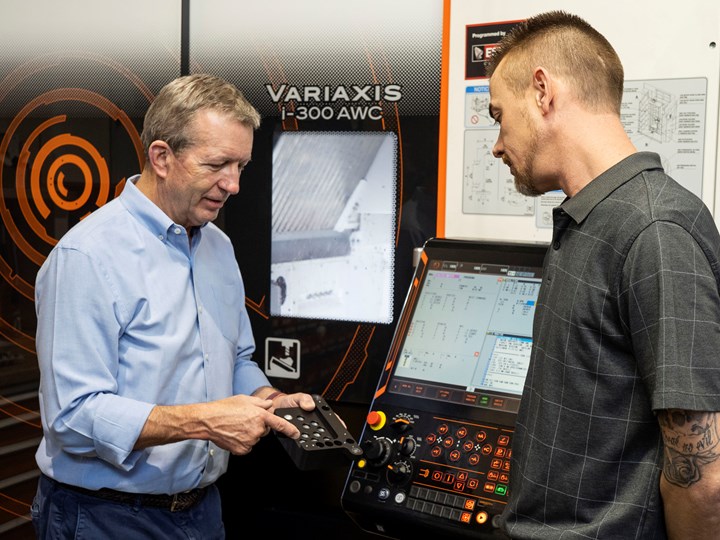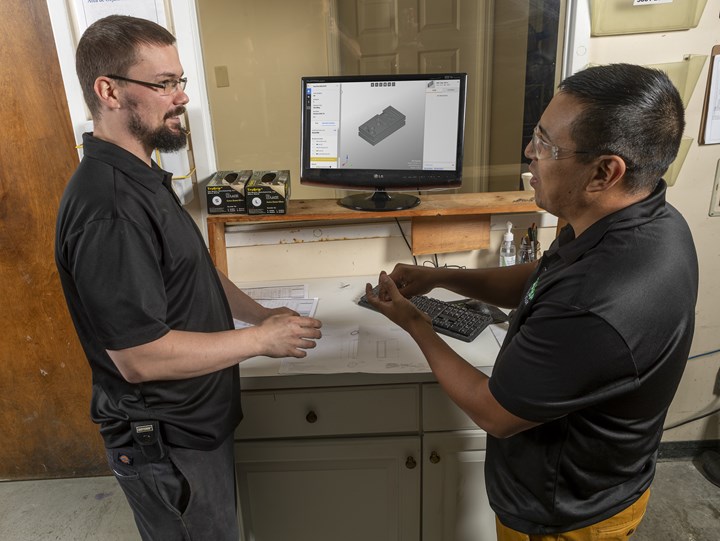Let’s Finish Closing the Quoting Gap
Sharing accurate, timely and actionable data is the key to an effective, respectful relationship between a machining job shop and the subcontracting finishing shop. Software that streamlines the quoting process can make this happen.
Share


“We want the finishing shop to feel as if it’s one of our internal departments,” says one manufacturing business leader. “We want the job shop to treat us like we are one of their internal departments,” says another.
The first statement above is a close paraphrase of comments made by Grady Cope, president and CEO of Reata Engineering, a machining job shop and contract manufacturer in Englewood, Colorado. Likewise, the second statement is a close paraphrase of comments made by Tamea Franco, president and CEO of Global Metal Finishing (GMF), a supplier of diversified metal finishing processes in Roanoke, Virginia. Although Cope and Franco have not met in person and neither company has done business with the other, their separate experiences illuminate new possibilities for bringing machining job shops and finishing suppliers together in new and mutually beneficial relationships.
These relationships are characterized by effective communication, even-handed cooperation and each party regarding the other as a respected partner. In short, the two parties must be as well integrated as two internal departments in one company. The primary means to this end is the same for both companies: software designed to streamline the quoting process.
A Win-Win Scenario
That a new generation of quoting software can act as a bonding agent between machine shops and providers of plating, painting or other specialty processes should not be surprising: the quoting process sets the terms for business transactions between the two parties. The right terms are essential to ensuring not only that work meets customer requirements, but also that both job shop and finisher are fairly rewarded. When shop and subcontractor fail to mesh their operations, finished quotes to prospective customers are less likely to be accurate, timely and successful. “The biggest challenge for a job shop like ours in preparing a quote is getting the right information from the right places at the right time, including cost figures and delivery dates from a finishing subcontractor” Cope says.

Although Reata relies on its multitasking machining centers – such as this Mazak Integrex i400 – to machine workpieces completely in one setup, the shop relies on finishing subcontractors for anodizing parts to customer specifications. Here, Grady Cope holds a typical close-tolerance aluminum part that requires precise masking before the application of an anodized finish. Photo Credit: Reata Engineering
On the other side of the country, GMF has experienced similar problems with metalworking job shop customers. Whether the job involves aluminum anodizing, precision hard coating, passivation, chromate treating or a custom service, GMF needs specific information to respond to a job shop’s RFQ. However, Ms. Franco says this information is often incomplete or difficult to determine. Making best guesses in the absence of this information can result in inconsistent pricing and uncertain scheduling commitments. “We need data, hard data,” she explains. “Anodizing, hard coating and other processes have to be approached scientifically. The chemistry and the electrical engineering in anodizing, for example, involve many precisely controlled variables, all of which are essential to success of the process.”
A New Quoting Philosophy
At Reata, quoting became a bottleneck in part because it does not occur with the predictable reliability of programmable machining operations, Mr. Cope says. The shop relies primarily on multi-tasking and multi-axis machining centers, all supported by investments in software, tooling, pallet systems and other automation, to produce complex aerospace- and medical-industry parts, mostly from aluminum. Keeping this equipment fed 24/7 with the right work requires estimators to possess not only the flexibility and capability to match the machines, but also creativity and resourcefulness. “It’s really as much art as science,” says David Hartfelder, Reata’s chief quoter and estimator. “Although we have had only a few misses, the process was still more time-consuming than we would like.”

In this example of a sample part shown in the Paperless Viewer as a finisher would see it, data necessary for a finishing quote is readily available. Photo Credit: Paperless Parts

This inset from the image above magnifies a key feature of the viewer – the chat panel that captures exchanges between team members as a record of their input. Photo Credit: Paperless Parts
Cope and Hartfelder agree that the Paperless Parts system delivered what they expected. Installed in full by September 2020, the software applies an intelligent pricing engine that interprets a CAD model of the workpiece according to cost variables customized to reflect the shop’s capabilities and constraints, Hartfelder says. Results are automatically formatted to produce an attractive, template-based presentation that can be emailed as a timely response to an RFQ.
In addition to streamlining the process, such capability has changed the shop’s overall quoting philosophy. “Pricing figures and delivery dates are consistent and close enough to ensure that if we get the job, it will be profitable,” he explains. “We could quickly identify the jobs that weren’t likely to be right for us, so we stopped wasting time on full-blown quotes for these parts. We also realized that issuing close-enough quotes and winning only 30% of them would keep our machines adequately busy.”
The software also has transformed how Reata communicates, both internally and with finishing suppliers. For example, the 3D workpiece models can be shared freely with finishers via a free Paperless Viewer account. As noted above, the uploaded model instantly provides the information the finisher needs to know, such as surface area, volume and weight. Capability to annotate the model is equally valuable, such as marking holes that need plugging, features that need masking and its preferred places for racking the parts during finishing. With this information, the finisher can ask questions or suggest options in a secure chat that is captured automatically as part of the quote file.
In the shop, one system add-on Hartfelder says is especially useful is Collaboration, a set of web-based communication tools that interface with the Paperless Parts quoting system for transmitting queries to inform shop personnel about the best way to machine a part. “We capture the exchanges digitally and make them a permanent part of the data packet associated with each job quote,” he says.
“In our experience, being able to reply to an RFQ within 24 hours greatly increases our chances of winning the job. Getting an accurate quote from the finisher within hours or even minutes contributes immensely to hitting that goal,” Hartfelder says. He also adds that if Reata does win the job, the finisher’s part of fulfilling the work is likely to proceed without a hitch as well.
And that brings us to the finisher’s side of the story.
A Stronger Partner
For GMF, improved communication has been essential to functioning as a fully trusted partner and revenue source to job shops. “Give me the right information and I can help a shop more effectively and increase its profits,” Franco says.

At Reata Engineering, Grady Cope (left) shows David Hartfelder an aluminum workpiece with black anodizing to verify the absence of visible rack marks from the finishing process. Reata worked with the finisher to develop special masking and racking procedures, along with customized rack hardware, to avoid these marks. In the background is the Mazak Variaxis five-axis machining center on which the part was produced. Photo Credit: Reata Engineering
Streamlined communications also are helping overcome job shops’ misconceptions about finishing work. “This is a problem not only for GMF, but also for our industry,” Franco insists. From experience, she believes that many machining job shops do not understand or value the work finishing companies do. “Finishing processes are as complex and demanding as any machining process,” she explains. “We face the same concerns about setup, process parameters and productivity as the machine shop.”
In fact, she contends that the finisher has other concerns that may not be familiar to the job shop, such as dealing with tasks that are not well-suited for automation. For example, racking (the process of placing parts on the hooks attached to the metal framework immersed in a tank) has to be done manually, despite efforts to automate it over the years. She says that at least 10 shop people touch every job that passes through.

Global Metal Finishing (GMF) exemplifies the two most important basics of success for a metal finishing company: reliance on sound and exact science and the attention of a skilled and dedicated workforce. Here, a technician makes final adjustments to parts arranged on racks for finishing by applying his experience, precise process parameters and well-maintained equipment for best results. Photo Credit: Global Metal Finishing
She says Paperless Parts software helps in three ways. First, quoting specialists gain quick access to the hard data they need. With the Paperless Parts system, the 3D model the job shop uploads has part volume, surface area and weight already calculated. Second, asking questions to the job shop issuing the RFQ is easy, and both parties capture the exchange in their respective job folders. Viewing the 3D model frequently reveals options to improve finishing processes. Running these suggestions by job shops for approval has resulted in process efficiencies, cost savings and prompter scheduling that may have been overlooked otherwise. Third, streamlined quoting templates return more accurate, consistent quotes in minutes rather than hours.
Franco also reports an unexpected but welcome benefit from streamlined quoting. Ashlynn Taylor in GMF’s dry-to-pack department noticed that requests for a certain rack number seemed to be trending upward. Because Paperless Parts’ software records quotes in a searchable database, Taylor could confirm this trend by checking the archived quoting activity. She urged the processing department to order more of that style right away, thus averting a potential bottleneck in the racking process.
Franco makes one last point about the benefits of the quoting software that is especially relevant in today’s environment of growing cybersecurity threats: “Paperless Parts software complies with Department of Defense requirements for data security. When we use this system, I know that critical data and intellectual property is safe, whether it’s our data or the customer’s data. All of us are protected.”
Coming Together
This brings us to a convergence of the finisher and job shop as partners able to cooperate as closely as operations under one roof. Cope and Franco see this development well within reach, and see it helping usher in a new era in U.S. manufacturing.
From the job’s shops point of view, Cope offers multiple examples of this progress. In one case, review and discussion via the software’s chat feature led to including a tab in a racking hole to speed and improve the plating process at no cost to the shop, which simply removed the tab during post-plating machining. In another case, a finisher asked the shop to fabricate various aluminum fasteners and washers to enable a quality electrical connection for anodizing a medical part. This request was handled with the same matter-of-course effort as a request from the company’s own shop floor (such as a CNC machinist asking the programming department for a change in fixture design).

The viewer enables GMF employees to consolidate their thinking when a quote is prepared. Because the 3D model includes calculations of part properties essential to finishing processes, employees can give more attention to optimizing these processes. Photo Credit: Paperless Parts
On the finisher’s side, Franco recalls a large piece of machined aluminum that lacked enough racking holes for even distribution of electrical current during plating. Examining the 3D model in the Paperless Parts viewer made the preferred electrical contact points easy to identify. “Our engineers worked with the shop’s engineers to be sure our racking suggestion was acceptable,” she recalls. “With their feedback, we arranged a racking pattern that minimized racking marks yet yielded a consistent and complete coating.”
The software also helps finishers and job shops sync their schedules. A direct link of communication facilitates progress updates that enable anticipating delays and adjusting scheduling priorities accordingly, Franco says. Providing clear, upfront scheduling requirements to job shops in the quoting phase also helps head off conflicts and avoid unwelcome surprises that can disappoint end customers.
Both companies also value the software’s integration with the ERP systems that they use for scheduling. At Reata, this integration has reduced manual entry of job data when the quote is accepted, Cope says.
Creating a Better Image
Can a quoting system change the image of an industry? Franco says yes. Ben Lawhorn, GMF’s VP of operations and sales, concurs. “This software is what the finishing industry needs to promote its value as well as create closer alignment and partnership with contract manufacturers,” he says. “The finisher and the job shop can learn from and help one another. Respect and understanding improve significantly, especially when both parties are using the same quoting software.”
There is even a recruitment benefit. At Reata, the quoting software and its centralized, integrated approach to capturing critical process data are contributing to the data-driven, fully digital mode of manufacturing envisioned in the Industry 4.0 concept, Cope says. That helps attract secondary and post-secondary students. “We can detect how the emerging image of manufacturing as an industry with an exciting, vibrant future is influencing their interest,” he says. Both Franco and Cope believe that strengthening the image and efficiency of America’s contract manufacturers and finishing companies boosts U.S. manufacturing at a time when its global competitiveness is at a pivot point.
Related Content
Orthopedic Event Discusses Manufacturing Strategies
At the seminar, representatives from multiple companies discussed strategies for making orthopedic devices accurately and efficiently.
Read MoreSolidCAM iMachining and Technology Wizard: Faster Machining and Longer Tool Life
Smarter toolpaths to tackle modern machining challenges.
Read MoreCutting Part Programming Times Through AI
CAM Assist cuts repetition from part programming — early users say it cuts tribal knowledge and could be a useful tool for training new programmers.
Read MoreThe Smarter Way to Take Full Control of Your CNC Machine Shop
Designed to bridge the gap between CAM programmers and shop floor operators, SolidShop provides a seamless, real-time solution for managing G-code, tracking production and eliminating costly mistakes.
Read MoreRead Next
OEM Tour Video: Lean Manufacturing for Measurement and Metrology
How can a facility that requires manual work for some long-standing parts be made more efficient? Join us as we look inside The L. S. Starrett Company’s headquarters in Athol, Massachusetts, and see how this long-established OEM is updating its processes.
Read More



























